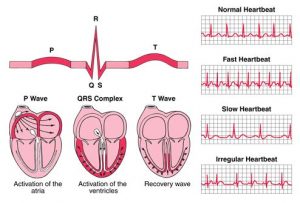Athletes: Beware of Possible Heart Condition After Positive COVID-19 Test
Doctors recommend student athletes who recently had COVID-19 receive an electrocardiogram before returning to their sport in fear that the individuals could have developed Myocarditis. Myocarditis is defined by the Mayo Clinic as “an inflammation of the heart muscle.” Typically, those of whom were encouraged to undergo an electrocardiogram experienced mild to severe symptoms of COVID-19. The asymptomatic are typically safe from the test.
Don’t panic. Possessing Myocarditis after having COVID-19 is found to be rare; however, doctors continue to advocate for procuring the electrocardiogram prior to regressing back to engaging in physical activity. They figure it is better to be safe than sorry. Symptoms of Myocarditis include, but are not limited to, pain in the chest, uneasy respiration, exhaustion and irregularities in the heartbeat. Arrhythmia, nonuniform pulsation of the heart, can be any of the following: beating too fast, beating to slow or heart palpitations.
I play soccer at North, so when I tested positive for COVID-19 in the middle of October, I was disappointed that I was going to miss two weeks of our pre-season conditioning. Little did I know, I was going to miss an entire month plus the skills training, separate from the school, that I was ecstatic to go to. I was finally administered my electrocardiogram on Dec. 4. One of the pediatricians at Roswell Pediatrics, Bridgette D. Guthrie, MD, suggested that I partake in “long distance walking and short distance jogging” but also reminded me not to push my limits.
The word electrocardiogram is lengthy and raises a few hairs, but the process is so simple that it is almost negligible. An electrocardiogram, better known as an EKG, measures your heart’s electrical activity according to Healthline. I had to wear a vest-like hospital gown because the nurse stuck about 12 stickers on various parts of my body including my chest, either side of my belly button and other parts of my abdomen. Laying flat on my back with my hands on either side of the examination table, each of the stickers were attached to the EKG machine by a wire that would track the electrical activity of my heart. Each beat shows up on a graph on the machine. My nurse took a few pictures of the graph to send to the cardiologist, who would send the results to my pediatrician who called my family to inform us. The procedure is fairly quick, so you don’t have to lay still for long. Mine took about five minutes.
Student athletes should be tremendously precautious in public areas by wearing their mask and washing their hands to avoid being out of practice or games. If they contract COVID-19, they will be out for 10 days plus however long it will take to receive the EKG and hear the results. Be safe Raiders!

Hey y’all, I am the Editor-in-chief with my other half, Emma Simmons. This is my last hurrah in Journalism, my fourth and final year. Outside of school,...





